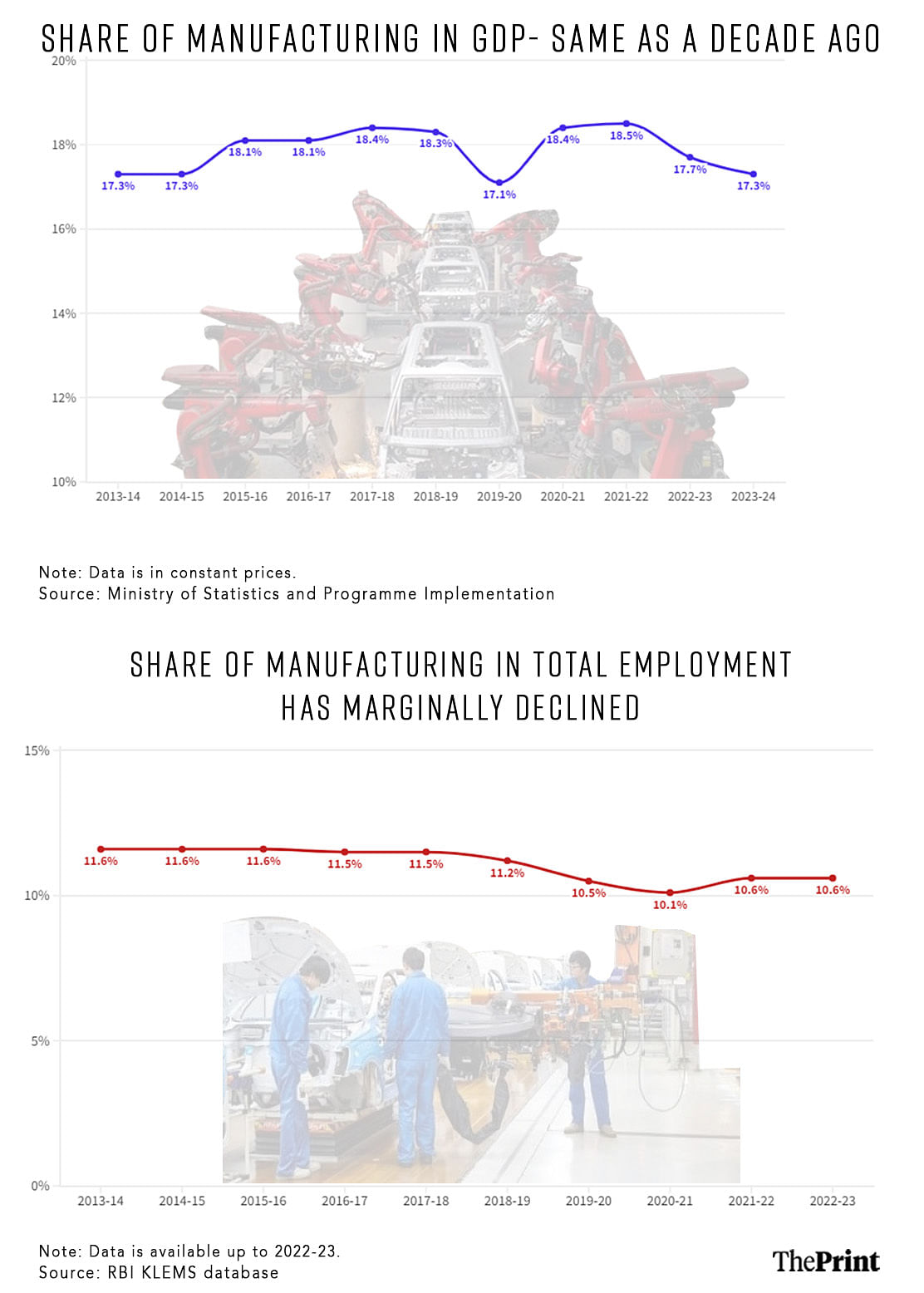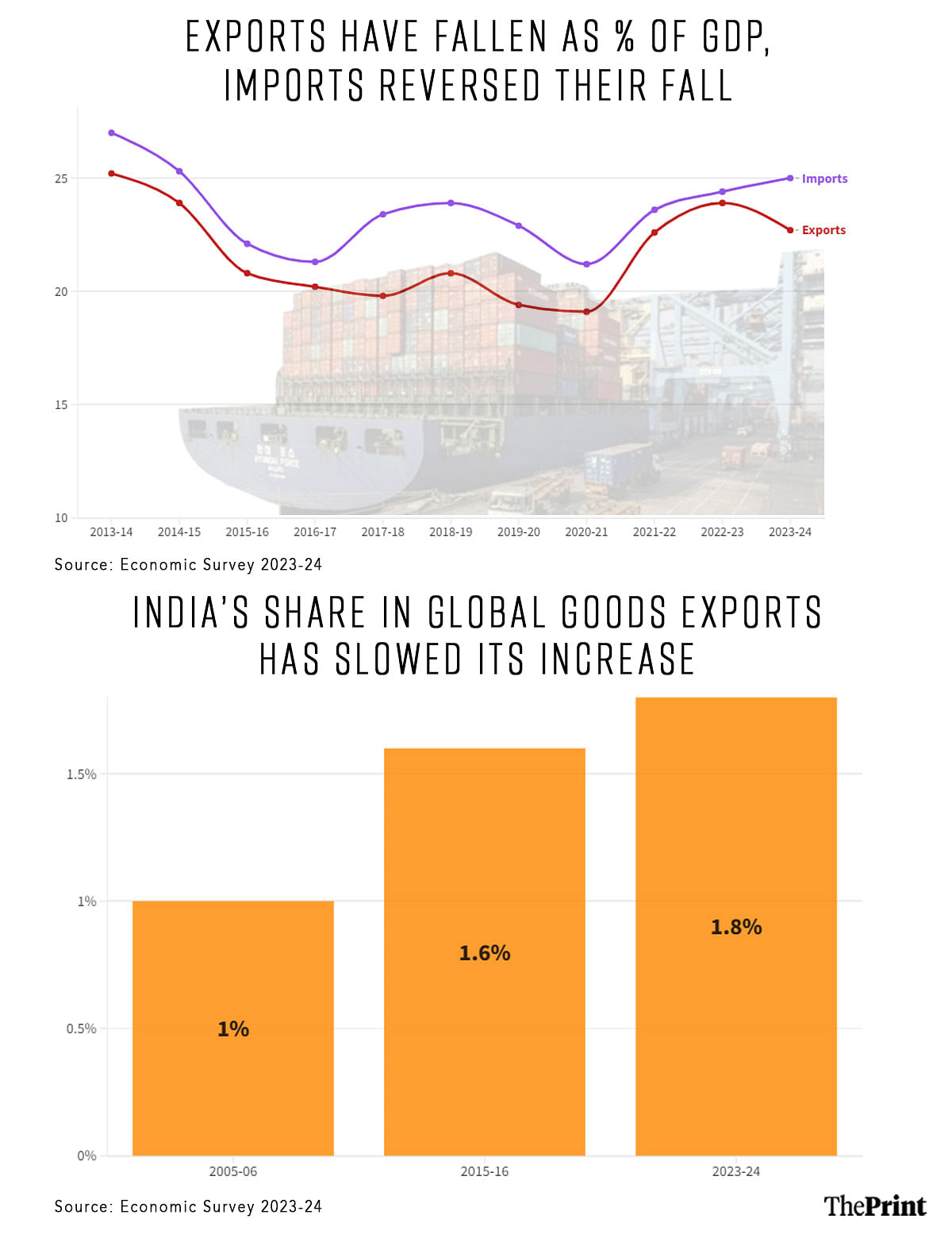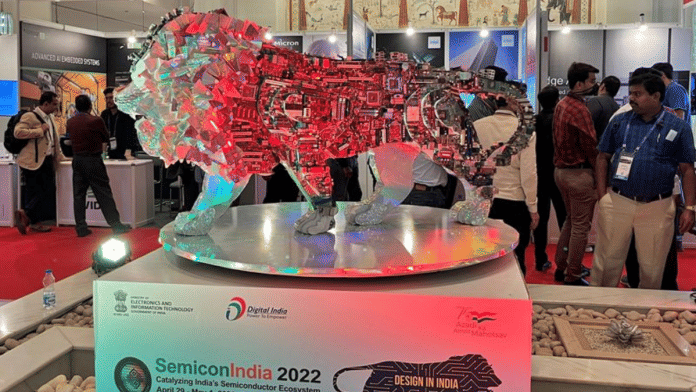New Delhi: Even as the Narendra Modi government celebrates 10 years of the “Make in India” initiative, an analysis of the country’s manufacturing and export performance shows the push to the sector has not increased its share in the GDP, in employment, or in global exports.
The government launched the “Make in India” initiative on 25 September 2014 to facilitate investment, foster innovation, build best-in-class infrastructure, and make India a hub for manufacturing, design and innovation.
On the 10th anniversary of the programme Wednesday, Prime Minister Narendra Modi posted on X, saying “Make in India” illustrated the “collective resolve of 140 crore Indians to make our nation a powerhouse of manufacturing and innovation”.

The government’s own data, however, shows the manufacturing sector has remained flat over the last decade in its contribution to the gross domestic product (GDP). Further, the sector’s share in total employment in the country has marginally declined over this period.
The country’s share in global merchandise exports has also largely stagnated over this period, and exports have seen a falling share in India’s GDP.
Manufacturing contribution unchanged
Data from the Ministry of Statistics and Programme Implementation shows the manufacturing sector contributed 17.3 percent to India’s GDP in 2013-14, a year before the “Make in India” initiative was launched. This rose to a little more than 18 percent over the next few years, to peak at 18.5 percent in the post-pandemic year 2021-22.
Since then, the sector has seen two consecutive years of declining share in the GDP — 17.7 percent in 2022-23 and 17.3 percent in 2023-24, the same as it was in 2013-14.
In fact, data for the first quarter of 2023-24 shows the share of manufacturing has dropped further to 15.7 percent.
Additionally, the Reserve Bank of India’s KLEMS database shows the share of the manufacturing sector in total employment in the country has marginally declined from 11.6 percent in 2013-14 and 2014-15 to 10.6 percent in 2022-23, the latest period for which there is data.
In other words, while employment in the manufacturing sector has grown, the “Make in India” push has not resulted in manufacturing outpacing other sectors of the economy in employment generation.
Exports have not benefited
Another priority area for the “Make in India” initiative was to boost exports and cut down on imports. The data over the last 10 years revealed the programme has failed to do the former but has been marginally successful in achieving the latter, although even this improvement has recently been reversing.

That is, India’s exports as a share of GDP has fallen from 25.2 percent in 2013-14 to 22.7 percent in 2013-24. In Q1 of the current financial year, it stood at an even lower 21.8 percent.
Data from the Economic Survey showed India’s share in global exports has grown much slower over the last decade or so as compared to the 2005-15 period. In 2005-06, India contributed 1 percent to global exports. By 2015-16, this had grown to 1.6 percent. However, by 2022-23, it stood at just 1.8 percent — a significantly lower increase.
The World Bank, in the latest edition of its India Development Update released earlier this month, made particular mention of India’s poor export performance in terms of contributions to GDP, in global value chains, and in employment generation.
“India needs to diversify its exports and increase its participation in Global Value Chains (GVCs),” the report said. “Over the past decades, despite rapid overall economic growth, India’s trade in goods and services has decreased as a percentage of GDP and India’s participation in GVCs has fallen.”
“Exports are also relatively concentrated in goods and services that tend not to be labour-intensive,” it added. “As a result, trade-jobs linkages are not fully exploited.”
A major factor behind this decline, the report added, was the high import tariffs India imposes on key inputs used by India’s manufacturing sector. These tariffs, the report added, have raised production costs and made producers less competitive in international markets.
Perhaps due to these high tariffs, the data showed that “Make in India” has managed to marginally reduce India’s dependence on imports, although even this trend has reversed in the last few years.
While imports amounted to 27 percent of GDP in 2013-14, it fell to 21.2 percent by the pandemic year of 2020-21. Since then, however, this proportion has been rising, logging 25 percent in 2023-24 – just a little lower than where it was in 2013-14.
(Edited by Tikli Basu)
Also read: India mustn’t skip the manufacturing train. Services alone won’t tap into demographic dividend







Modi has always been a hoax. A man who is very clever with words, but zero on implementation of anything. As an older man who has lived from as far back as Indira Gandhi’s days as PM, I can say that the business environment in India was best when Manmohan Singh was PM. That was when the Indian economy really boomed. Unfortunately, the economy has totally stagnated under Modi, whose sole interest is to remain in power. We need another Manmohan Singh for the Indian economy to again take off.
Under manmohan singh india was considered the fragile five economy.. He’s the biggest failure
I think that we get clear picture if same trends of some Global leaders are compared with the same parameters. What is the position of USA, China, Germany, Japan and France is same category can give us clear picture of this illustrations.
Forget about exports, ten years is too short to become self reliant in every sector. In a country where smart people either move out or compete for government service jobs, why anyone would be interested to get into manufacturing. Then, there are challenges like land availability, credit, corruption at government offices. Reformation must happen at every level. Make in India will be successful in few years, which will be much more visible than now.
I remember that event so well. Tycoons had flown in on their corporate jets. The hall was overflowing. Glitzy, as was to become the leitmotif. And see what the numbers show. Make in India should go back to the drawing board. Deeper integration with value chains, lower import tariffs, joining RCEP. A new Sherpa in charge.
Who in their senses will get into manufacturing in India. If anyone gets into it governments both state and centre will be the first to make the manufacturer’s life miserable. As it is manufacturing is a tough ask without being made to follow a plethora of rules and regulations, undergo harassment by petty bureaucracy and generally being treated as a criminal.
Let us look at it this way. With burgeoning population, unemployment being what it is, Corona and Covid , mercifully we have not sunk especially with Chinese consumables available at competitive affordable prices. The variable GST has of late compounded the challenges of manufacturers and startups. Let us admit these and find a way forward